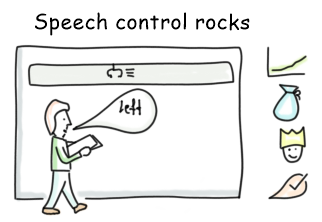The stars to road innovation framework wouldn’t be complete without the concept of stories. The story decides the fate of the innovation. It can prove to be very powerful.
Lets start with the headline of a story. Here is an example: Lets do speech recognition to control one of our noisy industrial production machines.

What is your reaction to that headline? You may want to consult the short introductory movie voice recognition lift-eleven, to gain full understanding.
A product manager producing such machinery told the story lets control our machines with speech recoginition to his fellow managers and to technical experts. The reaction he provoked where varied and included comments like: “Will never work”, “Don’t believe it”, “You’re nuts”. Well they all have experienced situations as in the movie above.
Good for him that he came well prepared. He did some experiments with the software of an external partner. And he could tell the managers that for as little as 20’000 Euros cash-out he could do it. With this he changed the headline: For a little sum I can actually create the unbelievable thing that we can control our machines with speech, despite the noisy environment. This obviously was too good a bait. “Well if he really wants to make a fool out of himself, let him”, some of them thought and others concluded: “Either we have a good hearty laugh or he can actually do it, which is even better.”
So the product manager took the 20’000 Euros and came back with a new version of the machine including the whole speech recognition thing. And yes, they can control the machines with speech recognition in the noisy environment. Euphoria lead into the machine being presented at the next trade fair.
So how was the reaction from customers and competition?
You probably guessed right. It varied and included sniggers from the competition until they realized it did work extremely well in the very noisy environment of the trade show and that it was just awesome.
Here is a good point to pause and contemplate three questions:
- #1 – Why is a story so important for innovation?
- #2 – What makes a story powerful?
- #3 – How can we come up with more powerful stories?
Did you already have some answers? Here are some more:
Curiosity or fear?
Have you ever tried to do something quite new in your organisation? And did it cross your mind that it would be best if the company would get rid of all those ignorants who refuse jumping up and down out of joy when confronted with your great idea? All would be so easy if it weren’t for the people getting in the way!


The tricky thing is that innovation makes existing expertise, knowledge, technological investment and even cash cows obsolete. People and organisations have to let go of something they are good at for something that they are ignorant of and has unforeseeable obstacles. Such a situation can easily trigger basic survival strategies like escape, attack, or just playing dead.
So here is where the story comes in. Humans like to stay put, even though that is a bad idea generally speaking. A good story inspires enough human mass to leave their home ground and venture into the unknown. A powerful story becomes true because people make the story happen. And that is the power of stories: Making something come true even if this involves facing unforeseeable dangers.

Promise, believe, foundation and emotion
Here are some of the ingredients a good story needs:
- A spoonful of Promise: The promise is desirable and makes enough people wanting the story to become true.
- One cup of Believe: The story must be believable, i.e. listeners must believe it could work for them.
- Two pints of Foundation: Humans are not stupid, at least sometimes. They love some hard facts that support the idea.
- A hundredweight of Emotion: Against all reasons, most of us are emotional and decide with heart and gut rather than the head. The head just confirms us that heart and gut were right from the beginning.
Have speech recognition: Belief is low, contradiction and laughs are the consequence. The story laugh at someones else’s expense is a workable promise and may leave you with 20’000 Euros.
Clothes invisible to those who are unfit for their positions, stupid, or incompetent. Very bad in terms of foundation, as the fairy tale tells. Still stories along this line are very prominent and if those using such stories make a successful exit, they at least are fine.
I recently used the story Electronic flute with mixed success. The group of around thirty people got all excited and asked me to play something once. They must have expected something exotic, or new, or extraordinary. Great promise, very bad foundation. An electronic flute is just a strange flute hooked up to a sound module and some loudspeakers and it sounds – like a flute. And a badly played flute stays a badly played flute.
Stories along the line we will save money pop up ever so often, usually backed-up by a lengthy calculation. The story is founded, but believing in a calculation you don’t really understand? The promise is in most cases not really great, you cannot gain much by just saving money. Saving money is only the means to use it for something much more promising, that would be the great promise. And finally, most important: very bad vibes. Saving money means loads of unnice things like cutting down budget, fire employees. It doesn’t inspire.
One laptop per child is a wonderful story from emotional side, its something that touches the heart and inspires new action. Compare with a laptop for $100. Reactions to the latter probably would have been “what for” and “can’t be done”.
Headline, experience, facts, action
The discussion about the ingredients above shows that a story must have more depth than just a headline. The headline is the attention grabber. It creates curiosity and a longing for the new world the story promises. Listeners will now want to learn more about this fantastic opportunity you are putting in front of them.
So its time for the next level of a story: the pitch. A pitch consist of a headline and three additional elements.
Experience: A way to experience the new world the idea promises. There are tons of great ways to achive this: Build a demonstrator, a mock-up, a design study or a hack and slash prototype; or tell a story with a video, a comic, or even role-play it; or let your customers tell the story four you. It just needs some creativity.
Facts: The hard facts and numbers deciders need. Basically these facts center around a few questions:
- Solution, i.e. for whom and in what context is it, what do these people try to achieve, three or four key features;
- Market, i.e. a few numbers about the market, size, share, competition, value capturing, partners, etc;
- Plan, i.e. who will do what by when, how much will it cost, what will it replace, how to tackle the big risks, first customers, and similar things;
- Feedback and Stats, i.e. statements of customers you talked to about what’s so great about the story, scores like net promoter value, etc.
Business Model Canvas, Lean Canvas, NABC as well as company specific idea sheets are just a few ways to manage the information of a pitch.
Call to Action: The pitch should turn listeners into team members, supporters, fans, sponsors, customers, users. The call to action gives them the opportunity to become involved and for you an opportunity to learn whether your idea and your pitch resonates with the listeners.
Telling the story to shape it
In order to have a powerful story you need to work on it. Tell it, explore it, prototype it, test it, learn and reshape it. And be ready to change any part of the story, even the headline.
So that’s it. A powerful story is a story that makes people venture into the unknown and risk everything – by itself, without an idea champion or a leader running around, hitting or inspiring people to finally take the idea up and do something useful with it.

Another twist of powerful stories is that they create a different point of view. It can be easily illustrated with the following saying: If you want a man to build a ship, create the desire to conquer new horizons, or so it goes. The powerful story changes the perspective of a person. Instead of thinking about the risk and the sweat involved, they start thinking about the wonderful experience of fulfilling their desire. Thus a powerful story creates an intrinsic motivation, that keeps people going through storms. A must have tool for a leader!